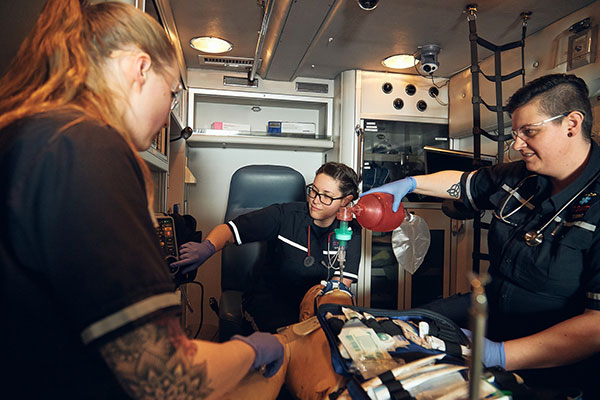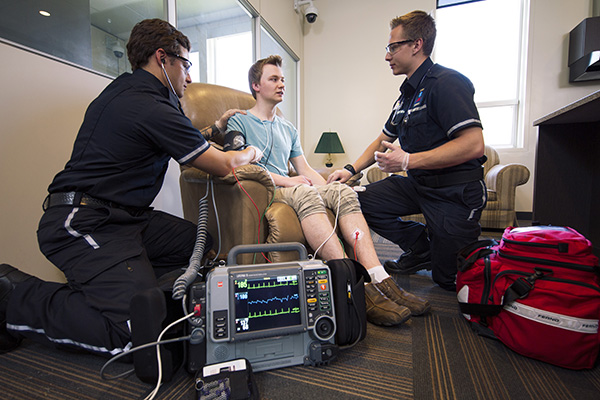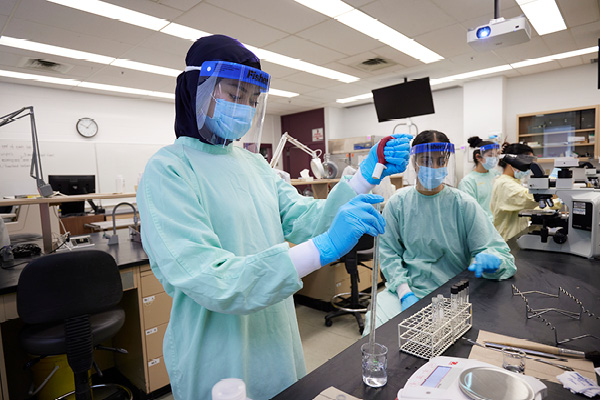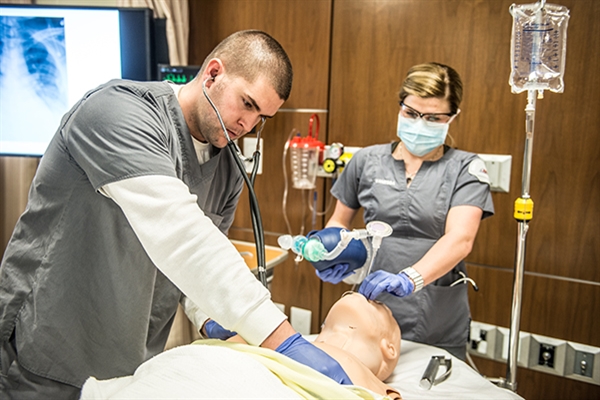On this page:
Mandatory requirements
Applicants for this program are required to have successfully completed the following SAIT programs or equivalent:
Review admission requirements for more details.
Overview
The Advanced Care Paramedic program is designed for those aiming to elevate their career in emergency medical services.
This extensive program equips you with in-depth knowledge of human anatomy, physiology, pathophysiology, advanced pharmacology and a range of medical interventions.
The first year focuses on foundational knowledge and building a strong theoretical base in human anatomy, physiology and pharmacology. You will:
- learn treatment protocols for various medical and traumatic emergencies
- gain proficiency in adult advanced life support and neonatal resuscitation protocols
- develop advanced patient assessment skills
- apply theoretical knowledge in a controlled environment through simulation laboratory classes.
The second year focuses on clinical experience. You will engage in clinical and ambulance practical placements for a real-world paramedicine experience.
For your practicum, experienced practitioners (preceptors) will mentor and oversee you in a clinical or practical setting. You'll also prepare for registration with the Alberta College of Paramedics.
The key features of year two include:
- specialized training in critical emergency interventions
- a combination of theoretical instruction and hands-on practice
- utilizing the Centre for Advanced Patient Care Simulation and our state-of-the-art Ambulance Simulation labs for realistic patient care scenarios.
This program is offered through on-campus and blended delivery models. In the blended delivery model, theory courses are delivered primarily online, while lab courses occur on campus. Both delivery models offer the same curriculum and require two years of full-time study.
Graduating from this program signifies your readiness to perform at the forefront of emergency medical services. With a curriculum that meets the highest accreditation standards and a strong focus on practical skills, you will be thoroughly prepared for the demands of being an advanced care paramedic.
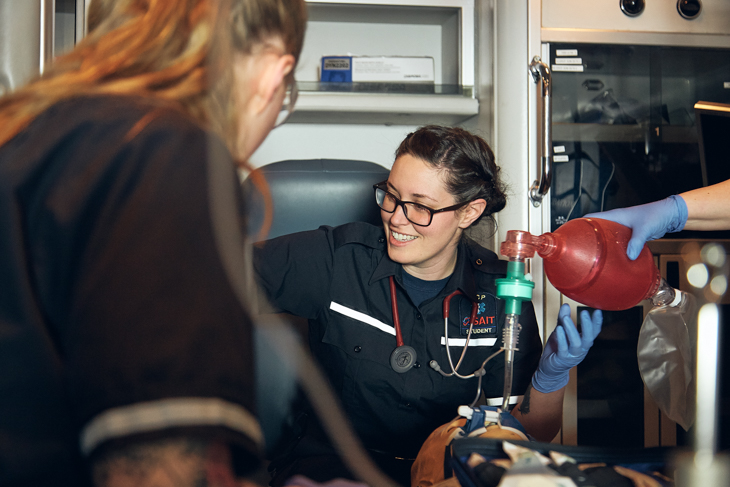
Just as we train our students to master clinical assessments and skills, it's equally important to invest in education that fosters their mental well-being.
Nathan Biswanger, SAIT Instructor and Advanced Care Paramedic

Paramedics tend to be innovative, methodical and objective.
You need:
- a strong desire to help those in need
- adaptability
- excellent communication skills
- attention to details
- sound decision-making and critical-thinking skills
- fine motor skills to provide advanced pre-hospital emergency care
- emotional self-regulation and the ability to remain calm, firm, reassuring and efficient in moments of crisis
- the ability to work alone and on a team
- a willingness to work extended hours and shifts, including nights and weekends
- to be comfortable with the sight of human blood and tissue
- to meet the job's physical demands, including spending most working hours on your feet, repetitively bending, and assisting with transporting, lifting and positioning patients or equipment.
All emergency medical personnel should be comfortable assessing injuries and illnesses, performing patient care procedures which may be sensitive, and wearing personal protective equipment (PPE) for extended periods. This includes exposure to latex and other disinfectant materials.
You are strongly encouraged to refer to the ALIS website for career, learning, and employment information for emergency medical personnel, the Paramedic Association of Canada occupational competency profile and Alberta Health Service's F.A.R.E. Paramedic requirements to ensure you can successfully meet the occupational requirements for the program and profession.
Some of these requirements include:
- lift a stretcher with a 95.5 kg (210 lbs) patient with a partner from a lower level to the load position and back down
- lift and carry a long spine board with a 95.5 kg (210 lbs) patient and ascend and descend ten stairs with a partner
- push a stair chair 10 m with 95.5 kg (210 lbs) and ascend and descend 20 stairs with a partner
- bilateral side carry of 9 kg (20 lbs) of weight in each hand
- front carry 18 kg (40 lbs)
- perform CPR for two minutes.
If you cannot obtain a tight facial seal while wearing a respiratory mask due to the presence of facial hair and refuse to shave for religious reasons, you will be considered unfit to work as a paramedic by Alberta Health Services (AHS) standards and will not be allowed to participate in practicum or successfully complete the program. Respiratory mask-fit testing is a requirement to participate in your practicum.
Applicants to this program are required to have completed the following SAIT programs or equivalent:
In the second year of this program, you'll participate in preceptor-supervised clinical and ambulance practicums.
You will be assigned practicum placements with consideration given to your preference of location. However, due to limited availability in Calgary, it might be necessary for you to travel or relocate outside the city.
Special considerations will not be accommodated. You will be responsible for covering the associated fees of the practicum, including entrance requirements, relocation, and travel costs.
In compliance with the practica agreements with our clinical partners, you will be required to provide specific documentation before you can participate in your practicum. Find out what requirements you need for this program.
This program is accredited by Accreditation Canada at the Advanced Care Paramedic level and meets the core competency requirements of the Alberta College of Paramedics.
Once you graduate, you're eligible to write the Canadian Organization of Paramedic Regulators registry exam, register with the Alberta College of Paramedics and work in Alberta as an advanced care paramedic.
You'll also receive the following certifications:
- Advanced Cardiovascular Life Support (ACLS)
- Pediatric Advanced Life Support (PALS)
- International Trauma Life Support (ITLS)
- Neonatal Resuscitation Program (NRP)
Upon successful completion of this program, you'll be awarded a SAIT Advanced Care Paramedic diploma.
Careers and opportunities
Each year, SAIT conducts a survey between February and April to determine the employment rate, salary and satisfaction of our newest SAIT alumni.
![]() 100% graduate employment rate
100% graduate employment rate
![]() $90,000 average starting salary
$90,000 average starting salary
Find out more about our graduate employment statistics >
Our graduates may work in the following occupations. Some careers require additional experience and education.
Associated National Occupational Classification (NOC) codes: 32102, 30010, 41404.

Career planning support
Unsure which career path is for you? Here are some recommended career planning resources to help you decide your future.
You can also head to Alberta alis for lots of information about careers in Alberta, including quizzes and labour market information to help you narrow down a path.
Finally, you can take our online career finder quiz, which can help narrow your options based on your current skills and interests.
Courses
The Advanced Care Paramedic diploma requires 60 credits (23 courses) to complete.
The program spans two years, with three semesters in year one, and two semesters in year two.
| Course | Credits |
|---|---|
|
Physiology and Physical Assessment will provide an integrated study of cellular anatomy and physiology of body systems. A comprehensive physical examination including history gathering and interview strategies will be emphasized. |
3 |
|
OBGYN & Pediatrics will focus on the pathology, assessment, and management of common obstetrical, gynecological, and pediatric illnesses and diseases. Neonatal emergencies will also be studied. Pharmacology specific to these patient cohorts will be emphasized. Equivalents:
|
3 |
|
Environmental and Aeromedical Emergencies will focus on the pathology, assessment and management of common environmental illnesses and emergencies. Aviation safety and transport will also be studied. Canadian Aerospace Medicine and Aeromedical Transport Association (CAMATA) certification will be awarded upon successful course completion. Pre-requisites:
One of:
One of:
|
1.5 |
|
Respiratory Emergencies will focus on the pathology, assessment and management of common respiratory illnesses and diseases. An overview of various techniques, tools, and medications used for managing adult airway and respiratory complications will be introduced. Attention will be given to reviewing the anatomy and physiology of the airway, the use of algorithms for airway management, managing upper airway abnormalities and a review of managing specific clinical circumstances. |
3 |
|
Paramedicine Laboratory 1 will provide students learning opportunities that will allow them to hone basic life support skills. The integration of scope of practice guidelines and high fidelity simulation will also be practiced. Students will demonstrate professionalism, leadership and effective communication behaviors during all learning experiences. |
3 |
|
This course focuses on action-based research methodologies. Students will examine healthcare systems and interventions in the field of emergency medicine using qualitative research methods. Areas of study potentially include: community-based paramedicine, healthcare education, and healthcare management. Pre-requisites:
Equivalents:
|
1.5 |
|
Paramedicine Lab 3 will focus on the integration of knowledge, skills and scope of practice guidelines in managing various patient groups studied throughout the paramedic program. High fidelity simulation will play a major role in the learning and evaluation process. This course will prepare the student for the final field practicum. Students will demonstrate professionalism, leadership and effective communication behaviours during all learning experiences. Pre-requisites:
One of:
One of:
|
1.5 |
|
Paramedicine Lab 2 will focus on the management of the adult medical and trauma patient. Strategies for integrating advanced paramedic therapies in a high fidelity simulation environment will be applied. Students will demonstrate professionalism, leadership, and effective communication behaviours during all learning experiences. Pre-requisites:
|
3 |
|
Advanced Trauma Management will focus on the pathology, assessment and management of traumatic emergencies. Advanced therapies including needle thoracostomy and suturing will also be studied. International Trauma Life Support (ITLS) Advanced certification will be awarded upon successful course completion. |
1.5 |
|
Cardiac Emergencies will focus on the pathology, assessment and management of common cardiac illnesses and diseases. Common toxidromes and advanced pharmacology will also be examined. Advanced Cardiovascular Life Support (ACLS) certification will be awarded upon successful course completion. |
3 |
|
Fitness and Wellness promotes physical fitness, mental health, nutrition and safe workplace strategies. Critical incident stress management (CISM) is also explored as a tool to help students develop a stress management plan to prepare themselves for the strenuous demands of the profession. Pre-requisites:
One of:
One of:
|
1.5 |
|
Special Population Groups will prepare students to recognize, assess and manage the needs of unique patient groups. Focus will be on the following patient groups: geriatrics, home care, cancer and terminally ill, psychiatric and behavioral disorders and substance abuse. Pharmacology specific to these patient groups will be examined. Pre-requisites:
One of:
One of:
|
1.5 |
|
Gastro/Urinary Emergencies will focus on the pathology, assessment and management of common gastrointestinal, urinary and endocrine illnesses and emergencies. Urinary catheterization, nasogastric intubation and pharmacology specific to gastro/urinary emergencies will be studied. |
3 |
|
Critical Care Paramedic will focus on the ongoing assessment of the critical care patient. Building on the knowledge and skills acquired in all studies to date, learners will be introduced to more advanced approaches to the treatment and inter-facility transport of the critical care patient. Advanced therapies and interventions including hemodynamic monitoring, transport ventilators, diagnostic imaging, and laboratory testing and interpretation will build upon the foundational paramedic learning to date. Pre-requisites:
|
1.5 |
|
Preceptor Training will prepare the paramedic graduate for future roles as mentors and preceptors in the emergency services and healthcare profession. Principles of adult education, learning and management styles and effective feedback strategies will be examined. Pre-requisites:
|
1.5 |
|
Pharmacology Basics will focus on medication classifications, calculations, safe medication administration, drug pharmacokinetics and pharmacodynamics. An introduction will be provided regarding the knowledge, safe practice and use of advanced care paramedic medications. Topics will also include Canadian drug legislation and the scope of practice guidelines that are specific to Alberta. |
3 |
|
Ambulance Practicum 1 provides learners with the opportunity to participate in a preceptor-supervised ambulance experience. This practicum will focus on the transition from basic life-support skills to introductory advanced life-support skills. Learners will be exposed to on-the-job opportunities that will allow them to apply the knowledge and skills acquired thus far in the program. Learners will work in collaboration with all members of the health care team and must demonstrate professionalism, leadership and effective communication behaviours during all learning experiences. Pre-requisites:
One of:
One of:
|
6 |
|
Students will participate in a preceptor-supervised learning experience in a hospital or approved healthcare facility. Students will work in collaboration with all members of the healthcare team and must demonstrate professionalism, leadership and effective communication behaviours during all learning experiences. Pre-requisites:
One of:
|
3 |
|
This course provides a preceptor-supervised ambulance experience. By the end of this course, learners will be required to perform competencies at the level expected for entry-level paramedics. Learners will be expected to demonstrate professionalism, leadership and effective communication behaviours at all times while working in a healthcare team. Pre-requisites:
Corequsites:
|
6 |
|
Students will participate in a preceptor-supervised learning experience in a hospital or approved healthcare facility. Students will work in collaboration with all members of the healthcare team and must demonstrate professionalism, leadership and effective communication behaviours during all learning experiences. Pre-requisites:
Corequsites:
|
3 |
|
Paramedicine Practice examines provincial legislation and ethical and communication practices relevant to emergency medical services. Students are made aware of personal communication styles and how their styles may differ from others. Emphasis is placed on teamwork and conflict resolution. Students will gain understanding of current research practices relevant to emergency medical services and healthcare. |
1.5 |
|
This course will prepare students for registration with the Alberta College of Paramedics. A variety of learning tools and assessment types will be used to allow students to practice the integration and application of the knowledge, skills, and judgment they have acquired throughout the program, in preparation for their roles as professional paramedics. Pre-requisites:
|
1.5 |
Progression
You must attain a PGPA and/or a CGPA of 2.0 or better each semester and pass the prerequisite courses to progress through the program.
To qualify for graduation, you must pass all courses, attain a CGPA of 2.0 or better and complete course requirements within the prescribed timelines.
Admission requirements
Applicants educated in Canada
All applicants must demonstrate English language proficiency and completion of the following courses or equivalents:
- Primary Care Paramedic certificate, or
- Emergency Medical Technician certificate.
Proof of completion must be submitted by August 1.
All applicants who were educated outside of Canada must demonstrate English language proficiency and provide proof they meet the program admission requirements with an international document assessment. Find accepted educational documents and assessment options.
SAIT may also accept courses completed at certain international post-secondary institutions.

Academic Upgrading
Missing an admission requirement for this program? Upgrade your prior education to help you receive admission into one of SAIT's career programs.

English language proficiency
All applicants must demonstrate English language proficiency prior to admission, including students educated in Canada.
Transfer agreements
At SAIT, we evaluate post-secondary credit you have previously earned and apply it to your SAIT credential. Explore our formal transfer agreements available for this program.
We can evaluate your prior education, even if we don't have a formal agreement in place.
Submit a transfer credit application
There are no formal transfer agreements currently in place for this program.
Transfer options for graduates
Build on the knowledge you’ve learned at SAIT. The opportunity to advance your education at an accredited post-secondary institution may be available.
🔗 Visit Transfer Alberta search tool for all transfer agreements in Alberta (including UCalgary, MRU and BVC).
If there are transfer agreements with other institutions outside of Alberta, nationally or internationally, they will be listed below.
Canadian Armed Forces
- Program name
- Medical Technician
- Available credits:
- n/a
If you are considering a future career with the Canadian Armed Forces, upon successful completion of this program, you may be eligible for advanced standing as a Canadian Forces Medical Technician.
As an accepted applicant, you will receive subsidized tuition, books and academic equipment, a salary with benefits and a guaranteed job upon graduation.
If you are starting your program at SAIT, you may apply to the Canadian Forces through their paid education program.
Visit the Canadian Armed Forces for more information.
Queensland University of Technology
- Program name
- Bachelor of Paramedic Science
- Available credits:
- 60
Upon successful completion of this program, you'll be granted advanced standing into year three of Queensland University of Technology's Bachelor of Paramedic Science.
Available intakes
Winter 2025
Start dates:
- Domestic students: Closed
-
-
Application deadline: Oct. 25, 2024
-
Fall 2025
Start dates:
- Domestic students: Open
-
-
Application deadline: June 30, 2025
-
- International students: Open
-
-
Application deadline: May 30, 2025
-
Costs
2024/25 tuition and fees
The following costs are effective as of July 1, 2024.
Domestic students
*You will be ineligible for the UPass during the third semester of your first year.
Books, uniforms and supplies are approximately $5,500 per full-time year.
This is a bring-your-own-device program with a standard computer hardware and software requirement. See the specific requirements on our computers and laptops page. An Apple tablet is required to support certain applications used in the program.
Find your booklist on the SAIT Bookstore's website. Booklists are by semester and made available approximately two weeks before classes begin.
Required personal protective equipment (PPE) and uniform
Uniforms and PPE are to be purchased before orientation day.
Print and take the uniform order form to Trademark Workwear Inc. to order your SAIT uniforms. Refer to the form for details and ensure you order your uniform early.
CSA-approved safety glasses and black steel-toed duty boots may be purchased where available.
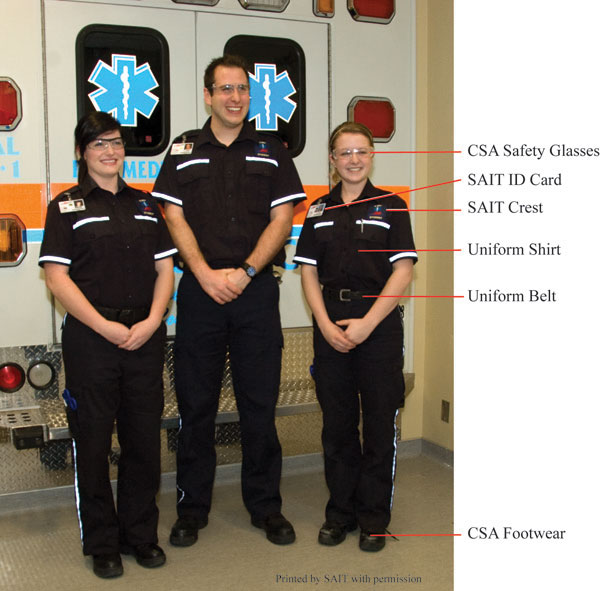
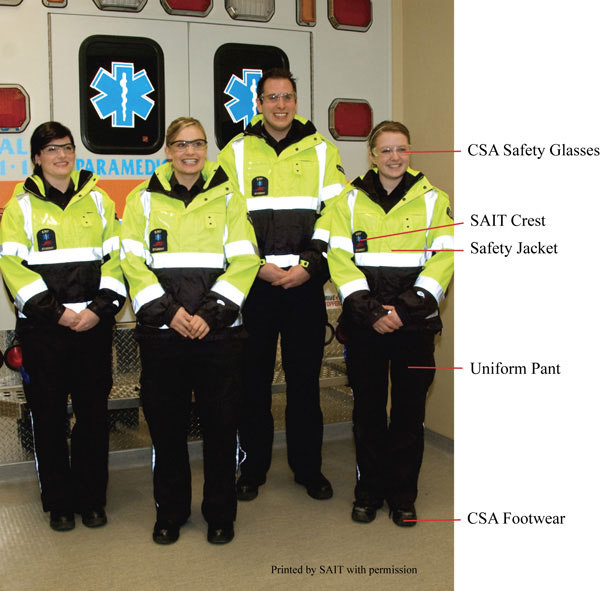
Ballistic vests
The SAIT paramedic programs do not require ballistic vests.
Many practitioners can be issued a ballistic vest by their employer as PPE. This is an employee's decision if they want the ballistic vest or not.
As a best practice for scene safety, police deem the situation safe before EMS crews enter, and our students are not first in any situation where this type of PPE is required.
If you wish to purchase your own ballistic vest for use on practicum, you can do so through the AHS-approved vendor Urban Tactical, Winnipeg, which has the required minimum specifications for a ballistic vest.
If you decide to purchase and wear the vest, you must ensure that your SAIT crest and student identification are clearly visible on the vest without compromising the integrity of the vest.
If you have a ballistic vest from an employer, you are not allowed to wear that employer's issue as part of the SAIT uniform.
If you choose to wear a ballistic vest during your program, you must purchase a personal ballistic vest.
Ballistic vests are personally fitted, have a limited lifespan, and are not resalable as they do not provide the appropriate protection second-hand. If you choose to wear a personal ballistic vest, you must wear it for every call during your practicum rotations.
Additional fees
- A fee of $75 per semester is associated with the CompTracker application used in this program.
- A fee is associated with obtaining a police information check, including a vulnerable sector check, payable to the police or the Royal Canadian Mounted Police (RCMP).
- You must have your immunizations reviewed by the SAIT Health Clinic. There is a $75 charge to review vaccine history. Any vaccines you need to be administered will result in additional charges.
- A fee of approximately $50 to $100 is associated with an electronic student permit checking submission, which is required for clinical practicum placements, payable to Synergy Gateway through the Verified software platform.
- You are responsible for additional expenses related to your practicum, including pre-practicum requirements and relocation costs to practicum sites outside of Calgary.
- There is a fee for the Alberta College of Paramedics (ACP) provincial exam and a registration fee of $475. Annual renewal fees are approximately $425.
- A Class 4 Driver's license may be required for employment. We recommend you review the Alberta government information for requirements and begin the process while in the program.
2025/26 tuition and fees
This program will begin to accept international applicants in the 2025/26 academic year. The following projected costs are effective as of July 1, 2025, and are subject to change.
Domestic costs will be shared in early 2025.
*You will be ineligible for the UPass during the third semester of your first year.

Financial aid
Paying for your education may feel overwhelming, but we have resources and programs that can help, including information about payment options, student loans, grants and scholarships.
Application process
Ready to apply?
Follow our step-by-step guide to submitting a successful application.
Communication during admission
Email is the primary source of communication during the admission process. Ensure your personal email account is managed appropriately to receive our emails, files and communications.
We recommend you add hps.info@sait.ca domain to your safe senders' list or you risk missing critical email messages.

Begin your application
Apply now using the online application portal.
Ensure you have a valid Visa or Mastercard to pay the non-refundable application fee of $120 for domestic applicants or $175 for international applicants.
Information sessions
Prepare for a strong start in your chosen program or get the details you need to decide your future path.
Our expert staff and faculty are ready to answer your questions and provide information about the following:
- What sets SAIT apart
- An introduction to the program and area of study
- Admission requirements
- Future career paths
- Information on the earning potential and graduate employment rates.
Contact us
School of Health and Public Safety Advising
-
Email - hps.info@sait.ca
Subscribe for updates
Your journey starts here! Sign up to get important updates on:
- Health and medical programs
- Application information
- Relevant news and events

Oki, Âba wathtech, Danit'ada, Tawnshi, Hello.
SAIT is located on the traditional territories of the Niitsitapi (Blackfoot) and the people of Treaty 7 which includes the Siksika, the Piikani, the Kainai, the Tsuut’ina and the Îyârhe Nakoda of Bearspaw, Chiniki and Goodstoney.
We are situated in an area the Blackfoot tribes traditionally called Moh’kinsstis, where the Bow River meets the Elbow River. We now call it the city of Calgary, which is also home to the Métis Nation of Alberta.
